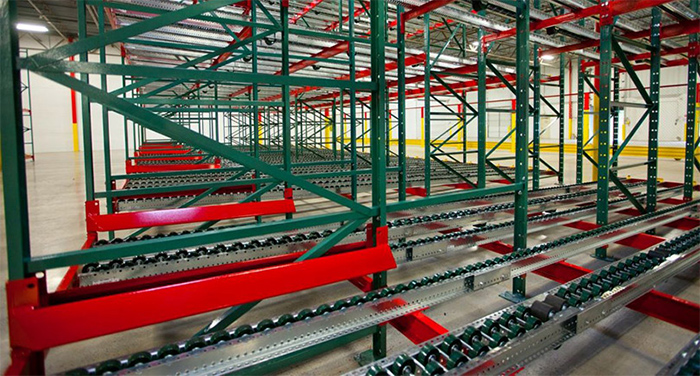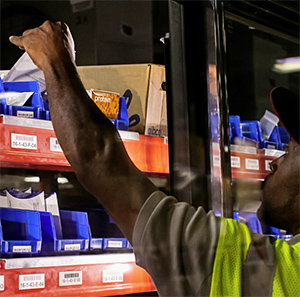First-In, First-Out Storage Considerations
Reduces product spoilage, improves picking, putaway processes and optimizes space

Above: a distribution center pallet flow application enforces FIFO picking protocol
In the age of eCommerce, fast shipping and obsolescence, first-in/first-out (FIFO) storage strategies are critical tools. Some products fit the mold (food, perishables, some electronics, medicines and many other retail goods), while other types of inventory are more about storage density and efficiency. The question is, what type of storage strategy works best for you? And what types of storage systems should you use?
Accessibility is critical, but so is organization
People tend to think of FIFO storage as regimented into carton flow or dynamic pallet racks, and that’s largely true. These types of storage enforce sequential picking. The first pallets or cartons stored in these racks flow to the front, where they are retrieved exactly in order as part of a queue. Whether that’s a pallet (usually picked by the full pallet) or a carton (the full carton can be picked in “case pick” operations, or anything stored in the carton in “each pick” operations), sequential storage systems efficiently enforce rotation.
What are your order picking options?
Picking/storage method |
Description |
Application notes |
| FIFO:
First-in, First-Out |
The first products that enter your systems are the first picked, typically reinforced by storage media like carton or pallet flow systems. Most FIFO storage enforces one SKU per picking slot (bays, storage bin positions).
Although not specifically FIFO, selective racks tend to be FIFO when full pallets are retrieved. |
FIFO is typically used for products that can spoil or degrade based on their time in stock, or that must be rotated for other reasons. Although foods and medicines are very typical loads, others can include almost anything, including manufactured components that should be used in current designs.
|
| LIFO:
Last-In, First-Out |
The last item stored is the first item picked in last-in, first-out storage systems.
This is typical of pushback racks, drive-in rack storage, and some static shelving or handpicked rack applications. |
LIFO picking is frequently executed for items that move quickly enough that rotation isn’t necessary and items that don’t spoil and do not require enforced product rotation. “Honeycombing” is possible in LIFO systems. This means that just one stored load (pallet, tote or carton) is placed at the picking position. This causes less handling, but it is very space-inefficient. |
| Floor Stacking | Stacking pallets on the floor is a last-in, first-out storage and picking method, as the most recently stacked top pallets are picked first. If there are multiple deep pallet stacks, then the last stack is picked first.
Also called block-stacking, this method is economical since no rack is required, but very space-inefficient. Floor stacking leads to honeycombing and poor ventilation. |
In a floor stack application, the loads must be substantial enough to support the weight of anything placed atop them — they shouldn’t be “crushable.” This can be alleviated using pallet stacking frames. Some other questions about floor stacking:
|
| Selective picking systems
Neither FIFO or LIFO, but can serve many load types |
Storage equipment like shelving and selective rack don’t tend to enforce any particular storage scheme. Pallets in a selective system are available to all pickers all the time. This is the same for bins of parts in static shelving. | In a selective picking layout, order pickers may have multiple pick options. In a selective rack system, if ten pallets are stored in ten different pallet positions, which is picked first? This tends to mean that selective picking is best suited for inventory that doesn’t expire and when rotation is unimportant. |
| Automated Systems
AS/RS and carousels |
Automated systems can help enforce a picking strategy by delivering products to pickers. Carousels and AS/RS can be programmed to deliver products in the desired method and can change on the fly in many circumstances. | Automated systems can mandate what product is delivered for picking, where and when. These solutions are expensive, but fit the right operation and situation. This tends to mean higher volumes of product moving in and out of the system. |
Who should use FIFO picking?

While the primary function of first-in, first-out systems is to rotate inventory, curb product obsolescence and reduce spoilage, these are hardly the only reasons to implement FIFO systems.
Aside from rotation, the method helps you utilize space efficiently and control warehouse organization. FIFO can help enforce processes and standard picking procedures as well as speed inventory replenishment. For accounting purposes, FIFO helps track asset value over time in an operation. FIFO also increases safety by reducing manual handling and forklift usage.
- Food and beverage
- Medical industry
- Pharmaceutical operations
- Electronics
- Automotive manufacturing
- Cosmetics and beauty
- General distribution companies
- Export operations
FIFO is commonly used by a variety of companies, even for items that aren’t prone to spoilage or require inventory rotation. We can help you design the right picking and storage systems for optimized operations. For fast assistance, contact us today.
Scott Stone is Cisco-Eagle's Vice President of Marketing with 35 years of experience in material handling, warehousing and industrial operations. His work is published in multiple industry journals an websites on a variety of warehousing topics. He writes about automation, warehousing, safety, manufacturing and other areas of concern for industrial operations and those who operate them.



